You think American airport security is a hassle, count your blessings.
Travel to problem areas in India is the ultimate in security stamps, frisks, and more stamps. Wh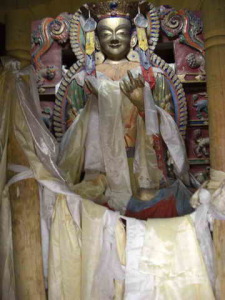 en I flew to Leh, capital of the most northern tip of India, an area called Ladakh, which is on the border of Pakistan and Kashmir, both disturbance areas, I had the security e
en I flew to Leh, capital of the most northern tip of India, an area called Ladakh, which is on the border of Pakistan and Kashmir, both disturbance areas, I had the security e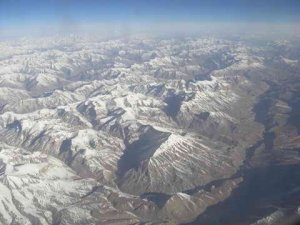 xperience of my life, even considering that everyone in this Indus Valley was cordial.
xperience of my life, even considering that everyone in this Indus Valley was cordial.
 en I flew to Leh, capital of the most northern tip of India, an area called Ladakh, which is on the border of Pakistan and Kashmir, both disturbance areas, I had the security e
en I flew to Leh, capital of the most northern tip of India, an area called Ladakh, which is on the border of Pakistan and Kashmir, both disturbance areas, I had the security e xperience of my life, even considering that everyone in this Indus Valley was cordial.
xperience of my life, even considering that everyone in this Indus Valley was cordial.At 4 a.m. in New Delhi, the airport was already packed. Why so early? There are only three flights a day to this very dry, very rocky, very high (12,000 ft) area and the slightest overcast is considered bad weather – a pilot has to have had a good nights sleep to weave through these steep razor sharp mountains, mostly packed with snow and ice and to land in a suggestion of an opening with one long tongue of black airstrip and do it safely. As one agent said, it depends on the vigor or courage of the pilot. Some won’t fly if there is anything “iffy.” Once I saw the air strip on one side of an enormous razor mountain, and the pilot had to swing around to the other side and come in easy, I realized it wasn’t as bad as it seemed. But, the run way needs repaving. It’s the military border patrol which is in charge of roads, airports, and general security.
way needs repaving. It’s the military border patrol which is in charge of roads, airports, and general security.
It’s the security issue that greets you at the airport. First you check in before you get to the check in counter. You flash the paper with your reservation at the military guard in brown. Then the baggage to be checked goes through an X-ray machine and you go through a personal station to be checked. There are the men’s side and the women’s side behind curtains. (That always gets me – a female guard is waiting to give you a good frisk.) Then you get to check in with the airlines – Jet Airways – and you receive your boarding pass and luggage ticket. Then when the flight is called, you stand in li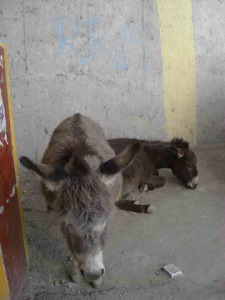 ne to go through security. This is the real thing. Your carry on and/or purse must have a special tag attached, a bag tag. When it goes through the security X-ray, you get a stamp at the other side. You go again through another personal security check – women on the women’s side with curtains – and you too get a stamp on your boarding pass. Now if that isn’t enough, then you must go to a special door and identify your checked luggage, still sitting on the baggage cart that will haul it to the airplane. When you eye ID it, you get another stamp. (No luggage will be put on the plane if you haven’t identified it on the baggage carrier outside.) Then, the flight is called. You show your boarding card to the military guard. You go through another personal security check and receive another stamp before you load on the bus that will take you to the plane. But you must also be approved by the soldier who makes sure you have all your stamps not only on your boarding pass, but on each carry on piece. So you get on the bus. And it takes you to the plane. When you get off the bus, you once again have to show all your stamps and your boarding pass to start up the steps to the plane. That fellow tears off part of the boarding pass. Then you get to the top of the steps and they check that you are who you are and you have seat nu
ne to go through security. This is the real thing. Your carry on and/or purse must have a special tag attached, a bag tag. When it goes through the security X-ray, you get a stamp at the other side. You go again through another personal security check – women on the women’s side with curtains – and you too get a stamp on your boarding pass. Now if that isn’t enough, then you must go to a special door and identify your checked luggage, still sitting on the baggage cart that will haul it to the airplane. When you eye ID it, you get another stamp. (No luggage will be put on the plane if you haven’t identified it on the baggage carrier outside.) Then, the flight is called. You show your boarding card to the military guard. You go through another personal security check and receive another stamp before you load on the bus that will take you to the plane. But you must also be approved by the soldier who makes sure you have all your stamps not only on your boarding pass, but on each carry on piece. So you get on the bus. And it takes you to the plane. When you get off the bus, you once again have to show all your stamps and your boarding pass to start up the steps to the plane. That fellow tears off part of the boarding pass. Then you get to the top of the steps and they check that you are who you are and you have seat nu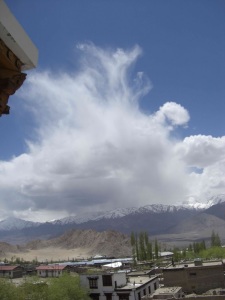 mber such n such. Of course, this kind of detail calls for big staff of young people who tediously do their job.
mber such n such. Of course, this kind of detail calls for big staff of young people who tediously do their job.
 way needs repaving. It’s the military border patrol which is in charge of roads, airports, and general security.
way needs repaving. It’s the military border patrol which is in charge of roads, airports, and general security.It’s the security issue that greets you at the airport. First you check in before you get to the check in counter. You flash the paper with your reservation at the military guard in brown. Then the baggage to be checked goes through an X-ray machine and you go through a personal station to be checked. There are the men’s side and the women’s side behind curtains. (That always gets me – a female guard is waiting to give you a good frisk.) Then you get to check in with the airlines – Jet Airways – and you receive your boarding pass and luggage ticket. Then when the flight is called, you stand in li
 ne to go through security. This is the real thing. Your carry on and/or purse must have a special tag attached, a bag tag. When it goes through the security X-ray, you get a stamp at the other side. You go again through another personal security check – women on the women’s side with curtains – and you too get a stamp on your boarding pass. Now if that isn’t enough, then you must go to a special door and identify your checked luggage, still sitting on the baggage cart that will haul it to the airplane. When you eye ID it, you get another stamp. (No luggage will be put on the plane if you haven’t identified it on the baggage carrier outside.) Then, the flight is called. You show your boarding card to the military guard. You go through another personal security check and receive another stamp before you load on the bus that will take you to the plane. But you must also be approved by the soldier who makes sure you have all your stamps not only on your boarding pass, but on each carry on piece. So you get on the bus. And it takes you to the plane. When you get off the bus, you once again have to show all your stamps and your boarding pass to start up the steps to the plane. That fellow tears off part of the boarding pass. Then you get to the top of the steps and they check that you are who you are and you have seat nu
ne to go through security. This is the real thing. Your carry on and/or purse must have a special tag attached, a bag tag. When it goes through the security X-ray, you get a stamp at the other side. You go again through another personal security check – women on the women’s side with curtains – and you too get a stamp on your boarding pass. Now if that isn’t enough, then you must go to a special door and identify your checked luggage, still sitting on the baggage cart that will haul it to the airplane. When you eye ID it, you get another stamp. (No luggage will be put on the plane if you haven’t identified it on the baggage carrier outside.) Then, the flight is called. You show your boarding card to the military guard. You go through another personal security check and receive another stamp before you load on the bus that will take you to the plane. But you must also be approved by the soldier who makes sure you have all your stamps not only on your boarding pass, but on each carry on piece. So you get on the bus. And it takes you to the plane. When you get off the bus, you once again have to show all your stamps and your boarding pass to start up the steps to the plane. That fellow tears off part of the boarding pass. Then you get to the top of the steps and they check that you are who you are and you have seat nu mber such n such. Of course, this kind of detail calls for big staff of young people who tediously do their job.
mber such n such. Of course, this kind of detail calls for big staff of young people who tediously do their job.Once you are on Jet Airways, you can smell the spicy flavors of an Indian breakfast about to be served. Masala Dosa, Keerai Wada, Kanjivarram Mini Idli was on my menu and that means an Indian style rice pancake filled with spicy potatoes and chutney, crisp deep fried lentel dumplings with spinach, savoy steamed rice cakes with cashew nuts, tumeric and fresh coconut. And that’s breakfast. (There’s yoghurt, cornflakes and rolls too.) So flying in these parts might be enough to scuff up your patience , but it’s interesting. Can you imagine this kind of service on American airlines? Americans wouldn’t stand for the inconvenience.
So th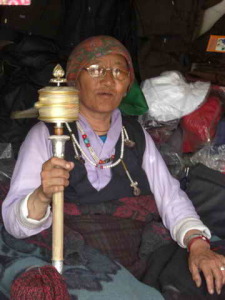 is was my introduction to Leh. The airport is run and operated by tall thin very very dark brown soldiers, many in army green turbans. They live in barracks painted with bright colored camouflage and the roads are stac
is was my introduction to Leh. The airport is run and operated by tall thin very very dark brown soldiers, many in army green turbans. They live in barracks painted with bright colored camouflage and the roads are stac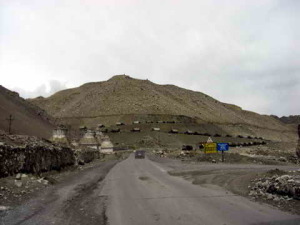 ked with military trucks and jeeps. There are also gaily painted trucks hauling food and goods across this part of the world. On the backs in large letters is painted BLOW HORN. I thought it was a brand of truck, but soon realized it was instructions to blow the horn if you want to pass. Most drivers spend most of their time driving with their hands on the horn, especially around these dead turns.
ked with military trucks and jeeps. There are also gaily painted trucks hauling food and goods across this part of the world. On the backs in large letters is painted BLOW HORN. I thought it was a brand of truck, but soon realized it was instructions to blow the horn if you want to pass. Most drivers spend most of their time driving with their hands on the horn, especially around these dead turns.
 is was my introduction to Leh. The airport is run and operated by tall thin very very dark brown soldiers, many in army green turbans. They live in barracks painted with bright colored camouflage and the roads are stac
is was my introduction to Leh. The airport is run and operated by tall thin very very dark brown soldiers, many in army green turbans. They live in barracks painted with bright colored camouflage and the roads are stac ked with military trucks and jeeps. There are also gaily painted trucks hauling food and goods across this part of the world. On the backs in large letters is painted BLOW HORN. I thought it was a brand of truck, but soon realized it was instructions to blow the horn if you want to pass. Most drivers spend most of their time driving with their hands on the horn, especially around these dead turns.
ked with military trucks and jeeps. There are also gaily painted trucks hauling food and goods across this part of the world. On the backs in large letters is painted BLOW HORN. I thought it was a brand of truck, but soon realized it was instructions to blow the horn if you want to pass. Most drivers spend most of their time driving with their hands on the horn, especially around these dead turns. With all these people in an area called Old Tibet because it once was a part of Tibet, and still mocks it geographically, spiritually and politically. Ladakh is one cold, dry, treeless, high place. Rocks poise on mountain sides just waiting for a reason to slide down. The one major road is paved, but it’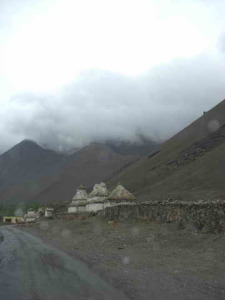 s one car width and the dare of who moves off the pavement first is ghastly. There’s not much room between one side and the devastating cliff on the other. I screamed a lot as we took one 40 mile drive to visit a palace which hangs high on a mountain and a monastery with a 1000 year old temple and three foot high images of the future Buddha (they believe in a Buddha coming again much like we believe Christ will come again
s one car width and the dare of who moves off the pavement first is ghastly. There’s not much room between one side and the devastating cliff on the other. I screamed a lot as we took one 40 mile drive to visit a palace which hangs high on a mountain and a monastery with a 1000 year old temple and three foot high images of the future Buddha (they believe in a Buddha coming again much like we believe Christ will come again ) in a model town called Aschi. But in all of this zone called Ladakh, there is a politeness and modesty and desire to please and the people smile a lot as they show off their sacks of apricots for sale (how many ways can you dry an apricot? From coffee brown apricots still filled with their nut to bright yellow chips so hard you can suck on one for a day. Maybe it’s the exotic spices that burns your lips when you eat Indian food. Everything is displayed in sacks at the markets.
) in a model town called Aschi. But in all of this zone called Ladakh, there is a politeness and modesty and desire to please and the people smile a lot as they show off their sacks of apricots for sale (how many ways can you dry an apricot? From coffee brown apricots still filled with their nut to bright yellow chips so hard you can suck on one for a day. Maybe it’s the exotic spices that burns your lips when you eat Indian food. Everything is displayed in sacks at the markets.
 s one car width and the dare of who moves off the pavement first is ghastly. There’s not much room between one side and the devastating cliff on the other. I screamed a lot as we took one 40 mile drive to visit a palace which hangs high on a mountain and a monastery with a 1000 year old temple and three foot high images of the future Buddha (they believe in a Buddha coming again much like we believe Christ will come again
s one car width and the dare of who moves off the pavement first is ghastly. There’s not much room between one side and the devastating cliff on the other. I screamed a lot as we took one 40 mile drive to visit a palace which hangs high on a mountain and a monastery with a 1000 year old temple and three foot high images of the future Buddha (they believe in a Buddha coming again much like we believe Christ will come again ) in a model town called Aschi. But in all of this zone called Ladakh, there is a politeness and modesty and desire to please and the people smile a lot as they show off their sacks of apricots for sale (how many ways can you dry an apricot? From coffee brown apricots still filled with their nut to bright yellow chips so hard you can suck on one for a day. Maybe it’s the exotic spices that burns your lips when you eat Indian food. Everything is displayed in sacks at the markets.
) in a model town called Aschi. But in all of this zone called Ladakh, there is a politeness and modesty and desire to please and the people smile a lot as they show off their sacks of apricots for sale (how many ways can you dry an apricot? From coffee brown apricots still filled with their nut to bright yellow chips so hard you can suck on one for a day. Maybe it’s the exotic spices that burns your lips when you eat Indian food. Everything is displayed in sacks at the markets. When you walk through markets, along with monks in maroon robes, shawls, t-shirts, beanies, and ochre yellow undergarments, there is a joy of faith in the people, who divert their walk to turn prayer wheels placed here and there on the stre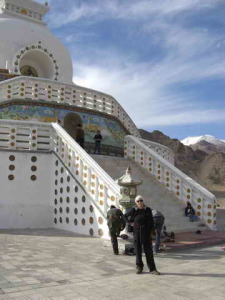 et, or to walk to the left side of a chortan. There are other giant white chortans that require a breath-taking hike up high – remember the altitude is higher here than the Grand Teton of Wyoming – but the brightly colored artwork on them is worth
et, or to walk to the left side of a chortan. There are other giant white chortans that require a breath-taking hike up high – remember the altitude is higher here than the Grand Teton of Wyoming – but the brightly colored artwork on them is worth the dizziness.
the dizziness.
 et, or to walk to the left side of a chortan. There are other giant white chortans that require a breath-taking hike up high – remember the altitude is higher here than the Grand Teton of Wyoming – but the brightly colored artwork on them is worth
et, or to walk to the left side of a chortan. There are other giant white chortans that require a breath-taking hike up high – remember the altitude is higher here than the Grand Teton of Wyoming – but the brightly colored artwork on them is worth the dizziness.
the dizziness.At one art enterprise in town which specialized in antique Buddhist artifacts, thongkas, jewelry (green turquoise and coral make up elaborate headdresses and necklaces once used by the Tibetan women in festivals) funny satin and silk hats that look like upside down vases, and others like Mongolian warriors with huge fur rims, and of course the never ending pashmina scarves – some embroidered, some printed, some with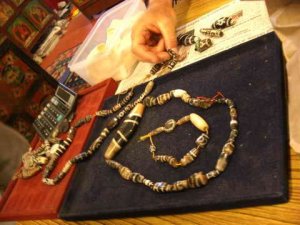 silk, some pure cashmere – and giant blankets of spangles and glitter made from parts of celebratory clothes, like necks and yokes. But what I learned anew is there is a diamond in the rough in Ladakh. It’s a world of its own – the fascinating Giks stone, a black and white agate which is found buried under tree roots, but in certain Asian markets is the
silk, some pure cashmere – and giant blankets of spangles and glitter made from parts of celebratory clothes, like necks and yokes. But what I learned anew is there is a diamond in the rough in Ladakh. It’s a world of its own – the fascinating Giks stone, a black and white agate which is found buried under tree roots, but in certain Asian markets is the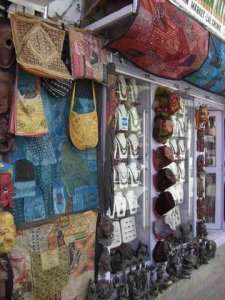 most sought after rock anywhere. One about a centimeter long with two eyes can cost about 5000 dollars. One not much bigger, depending on the white stripes and eyes in it, can run up to 20,000 dollars. These rare pieces have questionable origin, are valuable because they are really old, and somehow have something to do with the state of the health of those who wear them.
most sought after rock anywhere. One about a centimeter long with two eyes can cost about 5000 dollars. One not much bigger, depending on the white stripes and eyes in it, can run up to 20,000 dollars. These rare pieces have questionable origin, are valuable because they are really old, and somehow have something to do with the state of the health of those who wear them.
 silk, some pure cashmere – and giant blankets of spangles and glitter made from parts of celebratory clothes, like necks and yokes. But what I learned anew is there is a diamond in the rough in Ladakh. It’s a world of its own – the fascinating Giks stone, a black and white agate which is found buried under tree roots, but in certain Asian markets is the
silk, some pure cashmere – and giant blankets of spangles and glitter made from parts of celebratory clothes, like necks and yokes. But what I learned anew is there is a diamond in the rough in Ladakh. It’s a world of its own – the fascinating Giks stone, a black and white agate which is found buried under tree roots, but in certain Asian markets is the most sought after rock anywhere. One about a centimeter long with two eyes can cost about 5000 dollars. One not much bigger, depending on the white stripes and eyes in it, can run up to 20,000 dollars. These rare pieces have questionable origin, are valuable because they are really old, and somehow have something to do with the state of the health of those who wear them.
most sought after rock anywhere. One about a centimeter long with two eyes can cost about 5000 dollars. One not much bigger, depending on the white stripes and eyes in it, can run up to 20,000 dollars. These rare pieces have questionable origin, are valuable because they are really old, and somehow have something to do with the state of the health of those who wear them.There is more wealth in Leh in the Indus Valley than appears but new hotels are being built with elaborate Buddhist decorations, made of stones and wooden wind ows, and inviting the ever growing tourist to trek through its mountains. Here one crosses the Ganges, the holy river which is the lifeblood of all of India. All rivers flow into the Ganges. Here in Ladakh, it’s in its pure form. But when one gets to Calcutta, the garbage, debris and dead things floating in it begins to lessen its beauty. I’ll be there tomorrow.
ows, and inviting the ever growing tourist to trek through its mountains. Here one crosses the Ganges, the holy river which is the lifeblood of all of India. All rivers flow into the Ganges. Here in Ladakh, it’s in its pure form. But when one gets to Calcutta, the garbage, debris and dead things floating in it begins to lessen its beauty. I’ll be there tomorrow.
 ows, and inviting the ever growing tourist to trek through its mountains. Here one crosses the Ganges, the holy river which is the lifeblood of all of India. All rivers flow into the Ganges. Here in Ladakh, it’s in its pure form. But when one gets to Calcutta, the garbage, debris and dead things floating in it begins to lessen its beauty. I’ll be there tomorrow.
ows, and inviting the ever growing tourist to trek through its mountains. Here one crosses the Ganges, the holy river which is the lifeblood of all of India. All rivers flow into the Ganges. Here in Ladakh, it’s in its pure form. But when one gets to Calcutta, the garbage, debris and dead things floating in it begins to lessen its beauty. I’ll be there tomorrow.Photos: Future Buddha covered in Katas; View of Ladakh mountains from dirty plane window; another view; donkeys have it cool; clouds over Leh; military trucks in a row on a single lane road; woman with her personal prayer wheel; road chortans; almond man; climbing to a high chorten; monks in the market; valuable Giks stones; street ware including Tibetan hats; detail of a high chorten; an extreme palace, now pretty much abandoned.

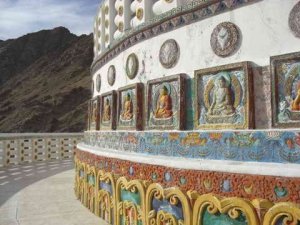
That’s a great trip you had. I always wanted to see the Himalayan but never got the chance. Especially Tibet is on my list of countries to visit. It seems that its culture and heritage is amazing. Thanks for sharing your insight with us.